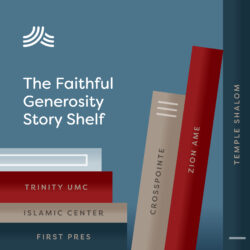Giving to Religion in Giving USA 2023
Giving to Religion in Giving USA 2023
This article is written by Anna Pruitt, PhD, Associate Director of Research at the Indiana University Lilly Family School of Philanthropy and Managing Editor of Giving USA: The Annual Report on Philanthropy.
by Anna Pruitt
Giving USA 2023: The Annual Report on Philanthropy for the Year 2022, revealed that giving to religion grew 5.2 percent in 2022 to a total of $143.57 billion. However, when adjusting for the 30-year high inflation rate of 8.0 percent, giving to religion declined by 2.6 percent. In Giving USA, giving to religion includes giving to congregations, religious media, and missions – it does not include religiously-motivated or inspired organizations. Even with this narrow definition, giving to religion receives 27 percent of charitable giving dollars, making it by far the largest recipient category of giving.
Giving in Context
The Giving USA report, released in June, is published by Giving USA Foundation and is researched and written by our team at the Indiana University Lilly Family School of Philanthropy at IUPUI. To better understand what is happening in giving to religion, it is helpful to understand the unique context for total giving in 2022. High inflation and the drop in the stock market created difficult conditions for giving in 2022 all around. In fact, total giving declined for only the fourth time in the last 40 years in current dollars. The decline in total giving follows the two best-ever years for charitable giving: 2020 and 2021. The acute needs created by the COVID-19 pandemic, recession, and movement for racial justice in 2020 were met with extraordinary generosity. Giving was further lifted by a strong performance in the S&P 500 for both 2020 and 2021. We are all living in unprecedented times, and the unusual results for giving in the last few years reflect this.
Giving to religion took a hit in 2020, declining by 0.4 percent in current dollars or 1.6 percent when adjusted for inflation. This decline followed the COVID-19-related closures of many congregations, many of which were not prepared to pivot to online services and online fundraising. In 2021, giving to religion recovered, growing 6.3 percent (1.6 percent adjusted for inflation). Though that recovery continued in 2022 with giving to religion growing in current dollars, it was not enough to outpace inflation in 2022. In fact, giving to religion in 2022 was still slightly lower than it was in 2020 when adjusted for inflation.
Understanding the Factors
There are several factors that help to explain these results: first, giving to religion is dominated by gifts from individuals, and giving by individuals declined by 6.4 percent in 2022 (-13.4 percent when adjusted for inflation). Households of all levels were impacted by the conditions of the year. The drop in the stock market likely dampened giving from high-net-worth donors, and the decline in disposable personal income (the amount that households have left after paying taxes) and high levels of inflation may have left households with fewer dollars to give to charity.
Secondly, multiple studies have reported that attendance rates for religious services have not yet returned to pre-pandemic levels. While some congregants have moved to online-only services, it appears that some individuals did not return after congregations stopped meeting in person. Growth in current dollars means that the households that did return are giving even more than they did in the previous year, however, they are not giving enough to keep up with inflation.
Thirdly, declines in religious affiliation may also be having an effect. The number of Americans who report that they are unaffiliated has been climbing in recent years. In the most recent Pew Research Center survey, 29 percent of adults reported having no religious affiliation, compared with only 16 percent in 2007. These types of widespread changes may have an impact in the long term for giving to religion.
Seeing the Bigger Picture
What do these results mean for the future of giving to religion? Our 40-year historical data set offers a reason to feel hopeful: giving to religion tends to grow slowly and steadily. The five-year annualized average growth rate for giving to religion is 2.8 percent. While this is slower than the 3.3 percent annualized average growth rate for total giving, it tends to be fairly consistent. We have also seen religion bounce back from each decline. After giving to religion dropped in 2008, at the height of the Great Recession, it grew again the following year, and over time, exceeded the previous highest level of giving.
There are other trends that are worth observing for 2023 and beyond. One study found that Millennials had actually increased their attendance levels in 2022 compared to 2016, demonstrating that it will remain important to reach out to younger individuals to help build the pipeline of donors. In addition, new financial tools such as low-minimum, religiously-focused donor-advised funds and digital giving cards gained traction in 2022 and may be a way to engage congregants in charitable giving. Time and again, we see that this sector is resilient—and innovative.
Anna Pruitt is the Associate Director of Research at the Indiana University Lilly Family School of Philanthropy and the Managing Editor of Giving USA: The Annual Report on Philanthropy, the longest-running annual report on charitable giving in the United States. Anna also works on The Philanthropy Outlook, a report that projects charitable giving for two years and explains how economic variables impact those projections.
Questions for Reflection
-
- Do you see the trends outlined above in your congregation? If so, what is the narrative about the change in giving?
- How can seeing the bigger picture of giving to religion over time help change the narrative of giving in your setting?
Expanded Perspective
 Below is a portion of this blog post, reprinted with permission from the author.
Below is a portion of this blog post, reprinted with permission from the author.
by Cesie Delve Scheuermann
Giving to religious institutions went up by 5.2%. Hooray! However, adjusted for inflation, giving went down by 2.6%. Boo!
Out of the ten “mission” areas measured by Giving USA only two (foundations and international affairs) were able to outpace inflation. Good for them.
What can you do with this information?
- Share it. Share it with your Finance Committee, your Generosity/Stewardship team, and your Leadership Team. They need to know how static giving does not mean more ministry. It doesn’t even mean the same ministry. It means less ministry.
- Empathize. Inflation is real. Rents are crazy high. Medical costs keep going up and so do groceries. This is not an easy time for many people in the pews.
- Talk about giving. There are some people who are unaware of the impact of inflation on ministry. They’ve been giving the same amount year after year without thinking about it. Challenge those people to pray about increasing their pledge or tithe.
- Pray. Pray for people who are adversely impacted by the economy. Pray for ways to minister to them. Pray for generous people to step up and fill the gap to overflowing so that more, not less, ministry can happen.
The 2023 Giving USA report is a little more doom and gloom than was hoped for. However, that doesn’t mean you have to respond in kind.
We are a people of hope and joy.
We serve a God of abundance.
Let’s believe it and go out there and live it!
Cesie Delve Scheuermann (pronounced “CC Delv Sherman,” yes, really) is a Stewardship Consultant for the OR-ID Annual Conference. She is also a Senior Ministry Strategist with Horizons Stewardship. For 25 years, while working as a volunteer and part-time consultant, she has helped raise over three million dollars for numerous churches and non-profit organizations. You can reach Cesie at inspiringgenerosity@gmail.com, at CesieScheuermann.com, or at cesieds@horizons.net.
A Conversation Starter from Lake Institute
 The Faithful Generosity Story Shelf highlights congregations and other religious organizations who have sought to use their assets and resources in creative—and sometimes surprising—ways as an expression of faithful giving. Each entry in our Story Shelf is short enough to be read and discussed during a committee meeting or other group gathering. Our hope is that these accessible vignettes will spark new questions, conversation, and imagination among clergy and laity about what might be possible with the funds, buildings, land, and other resources in their care.
The Faithful Generosity Story Shelf highlights congregations and other religious organizations who have sought to use their assets and resources in creative—and sometimes surprising—ways as an expression of faithful giving. Each entry in our Story Shelf is short enough to be read and discussed during a committee meeting or other group gathering. Our hope is that these accessible vignettes will spark new questions, conversation, and imagination among clergy and laity about what might be possible with the funds, buildings, land, and other resources in their care.
In-Person ECRF in Atlanta, GA
 Presbyterian College is partnering with Indiana University Lilly Family School of Philanthropy’s Lake Institute on Faith and Giving to offer the Executive Certificate in Religious Fundraising (ECRF) in Atlanta, GA.
Presbyterian College is partnering with Indiana University Lilly Family School of Philanthropy’s Lake Institute on Faith and Giving to offer the Executive Certificate in Religious Fundraising (ECRF) in Atlanta, GA.
This program allows participants the opportunity to earn a certificate in fundraising as they explore motivations for giving in the nonprofit sector. The class begins with a required two and half days in-person teaching sessions in Atlanta, GA September 18-20, one zoom call on October 4, and wraps up with a practical application project.
Subscribe
Insights, a bi-weekly e-newsletter, is a resource for the religious community and fundraisers of faith-based organizations that provides:
- Reflections on important developments in the field of faith and giving
- Recommended books, studies and articles
- Upcoming Lake Institute events

